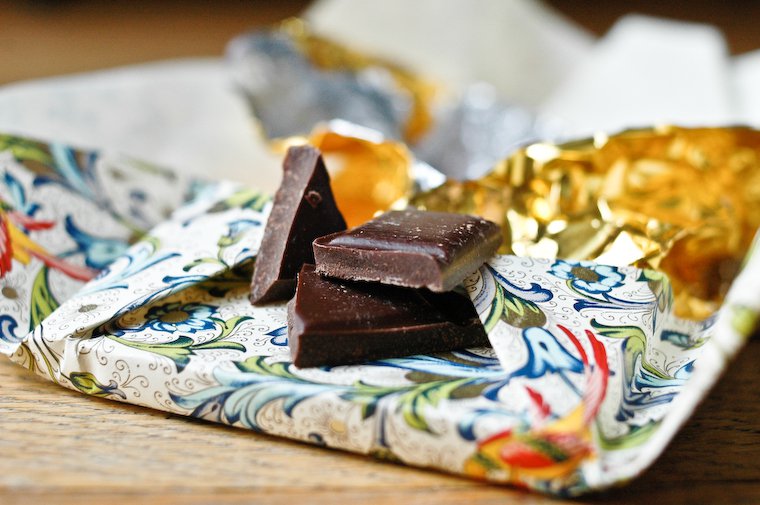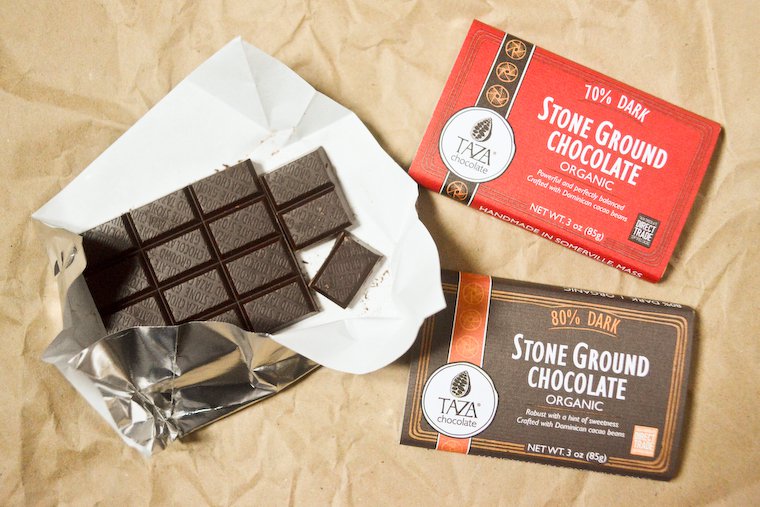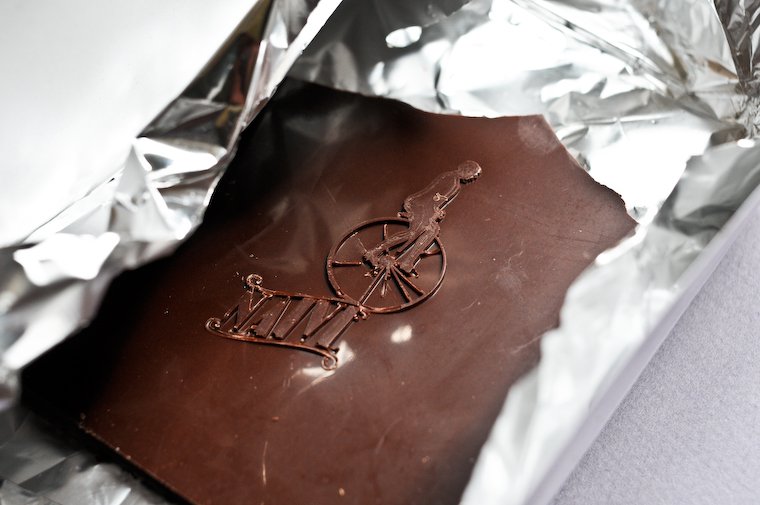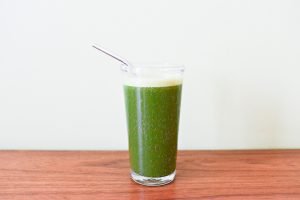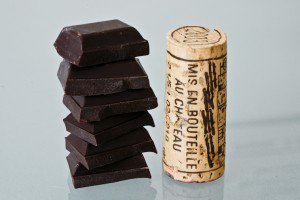Last week I had the good fortune of visiting Tain-l’Hermitage, a town in the southeastern quarter of France, near Valence. It is right in the middle of the Hermitage and Crozes-Hermitage wine country, in a gorgeous area that’s full of peach, cherry and apricot orchards. But me, I was there for the chocolate: Tain is also home to the Valrhona chocolate factory, and I’d been invited to take a tour.
We spent the day in paper hats, paper coats, and paper shoes (v. becoming), going in and out of large halls housing huge machinery, fat bags of cacao beans and ripples of chocolate, breathing in the intoxicating scents cacao emits as it is submitted to the many torments (cleaned, roasted, husked, crushed, ground, conched, molded, cooled, wrapped) that will turn it from bitter bean to the voluptuous antidepressant we know and love.
And the only thing I love more than chocolate is understanding how stuff works, so this was very much my idea of a happy Tuesday — despite the fact I’d had to get up at 4:45am to take the train, but I am nothing if not committed.
Most of the flavor components of chocolate are “trapped” in the cacao butter, and it’s only when the chocolate melts that they are released. Conveniently, the magic happens right around mouth temperature.
At the end of this full and instructive day, we were treated to a session with Vanessa Lemoine, the in-house expert in sensory analysis, a discipline in which the five human senses are used to describe and analyze products.
Among her responsibilities at Valrhona, she is in charge of training the chocolate tasters who assess the ten-kilo samples that are sent ahead of any cacao shipment. The beans from each origin are expected to conform to a particular flavor profile, according to the particularities of the cacao variety, the region’s terroir, and the production method that Valrhona and the growers have agreed upon. Any crop that differs significantly from that profile won’t be accepted for purchase. This is to ensure that the quality and personality of the single-origin chocolates as well as the blends remain steady, so that the chocolatiers and pastry chefs who have built their own recipes on a particular chocolate can in turn offer consistency to their customers.
The thing is, you can’t judge a crop by its bean: at this stage, the aromatic components are dormant, and its full potential will only be revealed after the beans are processed and turned into actual chocolate. So the sample beans go through a mini production line, and emerges as chocolate the tasters will grade along thirty different descriptors. A tough job, I’m sure — and I’m not being ironic.
It takes many training sessions to reach the finesse of palate that’s required of these tasters, but Vanessa Lemoine gave us a short primer on how to taste chocolate, and I thought it so interesting I wanted to share it here. The process is in some ways similar to wine tasting, so if you’re a honed wine taster, you’re that far ahead.
As I’m sure most of you are aware, an estimated 90% of what we call “taste” in common speech is in fact perceived by the nose: directly at first, as we breathe in the smell of the food, and then indirectly, once the food is in our mouth and we start chewing, as we breathe out air that is charged with new aromatic components that have been released by the mastication. This second phase is called retro-olfaction — reverse smelling, if you will.
The mouth itself perceives sensations of coolness, hotness, and spiciness, and the tongue’s receptors feel acidity, sweetness, saltiness, and bitterness*.
The modus operandi Vanessa Lemoine prescribes is to taste a single chocolate in two or three takes, breaking off a small chunk of chocolate (about a third of a square) with your fingers each time: a lot goes on in the mouth and nose when you eat chocolate, so you’ll need a few tries, focusing on different aspects at each bite. She also advises against tasting more than four or five different chocolates during a single session, because the senses quickly become saturated.
Look at the chocolate first: note whether it is shiny or matte, and what shade of brown it is — milky, mahogany, ebony? Notice how the chocolate breaks off, too: does it snap (a desirable quality) or is it pliable?
Although it is interesting to smell the chocolate at this point and note your impressions, you’ll likely find little to write about: most of the flavor components of chocolate are “trapped” in the cacao butter, and it’s only when the chocolate melts that they are released. Conveniently, the magic happens right around mouth temperature.
So next you’ll place a piece of chocolate in your mouth, chew briefly to accelerate the release of the flavor components, then let the chocolate melt between your tongue and the roof of your mouth, and concentrate on your sensations.
The first component that will manifest itself is acidity: if the chocolate is acidic (which is not a fault, unless it’s overwhelming), it will trigger salivation right away, and you’ll feel it on the sides of your tongue and underneath it. Note the scale of this sensation, and whether it fades quickly or stays with you throughout the tasting.
Breathe out through your nose slowly with your mouth closed, and try to describe the aromas you perceive through retro-olfaction. They will appear in stages: the first ones you’ll get are the fleeting, delicate notes of fruit or flower, followed by warmer notes of spice, roasted nuts, or toasted bread. Woody, malted or earthy notes will appear in the finish. Note the intensity of each aroma. Vanessa Lemoine noted that any smoky or smoked aroma in chocolate was, in her view, a defect.
The aromas will appear in stages: first come the fleeting, delicate notes of fruit or flower, followed by warmer notes of spice, roasted nuts, or toasted bread. Woody, malted or earthy notes will appear in the finish.
Try to be as specific as possible in describing the aromas: if you sense something fruity, is it berries, is it stone fruit, is it citrus? Is it a fresh fruit aroma, or a jam-like one? If the chocolate is floral, is it jasmine, rose, orange blossom…? It can be a real brain challenge to put a name on the aroma you’re smelling, but you’ll get better with practice. It’s helpful to conduct tastings with other people, too, so you can share impressions.
Bitterness will make its presence known toward the end, and it will become more and more noticeable and persistent in subsequent bites. Bitterness is perceived by receptors placed at the back of the tongue in a V formation (pointing toward the throat**), so be attuned to a sensation in that region of the mouth: is it strong? Does it linger?
You should also note the texture of the chocolate on your tongue: does it feel dry and brittle (not a good thing), or is it lithe and fresh, or is it creamy, so creamy as to coat your tongue and the roof of your mouth?
Taste a second and possibly a third small chunk of chocolate until you feel you’ve explored all of these aspects, and try to describe the overall experience. You can draw inspiration from some of the adjectives Valrhona uses to describe their chocolates: rounded, warm, fruity, fresh, tangy, floral, oaky, tannic, sweet, bittersweet, caramelized, powerful, intense, balanced, elegant, velvety, creamy… and add negative ones if the need arises.
Between chocolates, it’s good to reset your palate by drinking water and/or eating a bit of bread (crumb only) or a slice of apple.
This method was described to us in the context of tasting plain chocolate, i.e. not flavored with anything other than vanilla or malt (standard flavor enhancers for chocolate), but I’m sure it could also be used to assess flavored chocolate bars, covered ganaches, and other chocolate confections.
[Pictured above is chocolate from Brooklyn’s Mast Brothers.]
* Vanessa Lemoine did not mention umami or how it factors into this tableau, though I’m sure she’s aware of its existence. Perhaps she omitted it here because umami does not typically figure into the flavor profile of chocolate?
** Poisonous or inedible wild berries are bitter, so the V-shaped formation is thought to be designed as a barrier, allowing gatherers to spit them out before it was too late.


